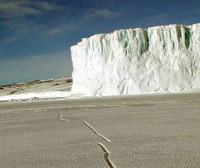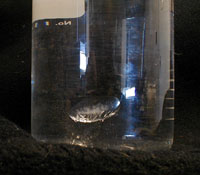|
|

|
|

|
The
Barne glacier soars 150 feet (50m) above the sea and extends
1500 feet (500m) below. Click to enlarge.
|

|
|
|
|

|
|
Iron
Science Teacher
|

|
Science
Teaching from Antarctica
by Paul Doherty
December
15, 2001
Our
video link to the Exploratorium allowed me to compete in the
special holiday edition of
Iron
Science Teacher
. Host Linda Shore opened the program by
introducing the contestants: Eric Muller, Ken Finn, and me.
Linda explained the rules: we would be given a secret ingredient
then have to create and present a science lesson using that
ingredient. The secret ingredient was....ice! How appropriate
for an Antarctic science lesson.
Eric Muller
went first. He put on protective goggles, then boiled water
in a flask. He took the flask off the heat, and as it cooled,
he plugged it with a stopper. As the gas cooled, a vacuum
was created in the flask. The lowered pressure allowed water
to boil at lower temperatures. He was then able to place ice
cubes against the bottom of the flask and start it boiling
again. A great and surprising experiment!
Ken
Finn soaked his hand in ice water for 20 minutes and then
tried to write his name. He had great difficulty. When you
cool the nerves in your hand, they do not send electrical
signals as well as when they are warm. In addition, the cooled
muscles in his hand did not work as well. I mentioned that
I had done a similar experiment in Antarctica when I tried
to erect my tent with cold hands.
For
my experiment, I placed ice cubes in a tall glass beaker full
of water. They floated, just as icebergs or glaciers would
float, with 10% out of the water and 90% underwater. I then
replaced the ice cube with frozen milk. As the frozen milk
cube melted, streamers of white milk settled to the bottom
of the beaker. The cold milk liquid is denser than the warm
water, and so the milk liquid sank to the bottom of the beaker.
This is the same thing that happens in Antarctica when cold
icebergs, with temperatures below freezing hit the sea ice.
The sea ice freezes around the berg. But when the sea ice
freezes, the salt in the sea ice is left behind as pure fresh
water crystallizes onto the berg. The salt creates a cold
dense solution that sinks down toward the ocean floor. The
sunken cold salt water freezes the water at the bottom of
the sea and creates strange ice structures.
|
|

|
|

|
An
ice cube floats above a water layer and beneath a layer
of rubbing alcohol. Click to enlarge.
|

|
|
|
|

|
In
the second part of my experiment, I half-filled a beaker with
a 90% solution of rubbing alcohol, or isopropanol, and dropped
an ice cube in it. The ice cube sank to the bottom, since
ice is denser than isopropanol. I added many ice cubes and
waited for them to melt on the bottom of the beaker. This
created a dense layer of water beneath the alcohol. When I
added another ice cube, it hovered in the middle of the beaker,
floating at the boundary between the alcohol and the water.
As the ice cube melted, air bubbles trapped in the ice rose
toward the surface.
Antarctic
glacier ice also has trapped air bubbles. These bubbles are
squeezed beneath hundreds of feet of ice and so are under
high pressure. When you add ice cubes carved from a glacier
to your drink, they rupture and make a loud musical ping.
Then
it was time for the audience to vote. All of the contestants
got applause, but I narrowly squeezed out a victory. Now I
can call myself the Iron Science Teacher of Antarctica!
|

